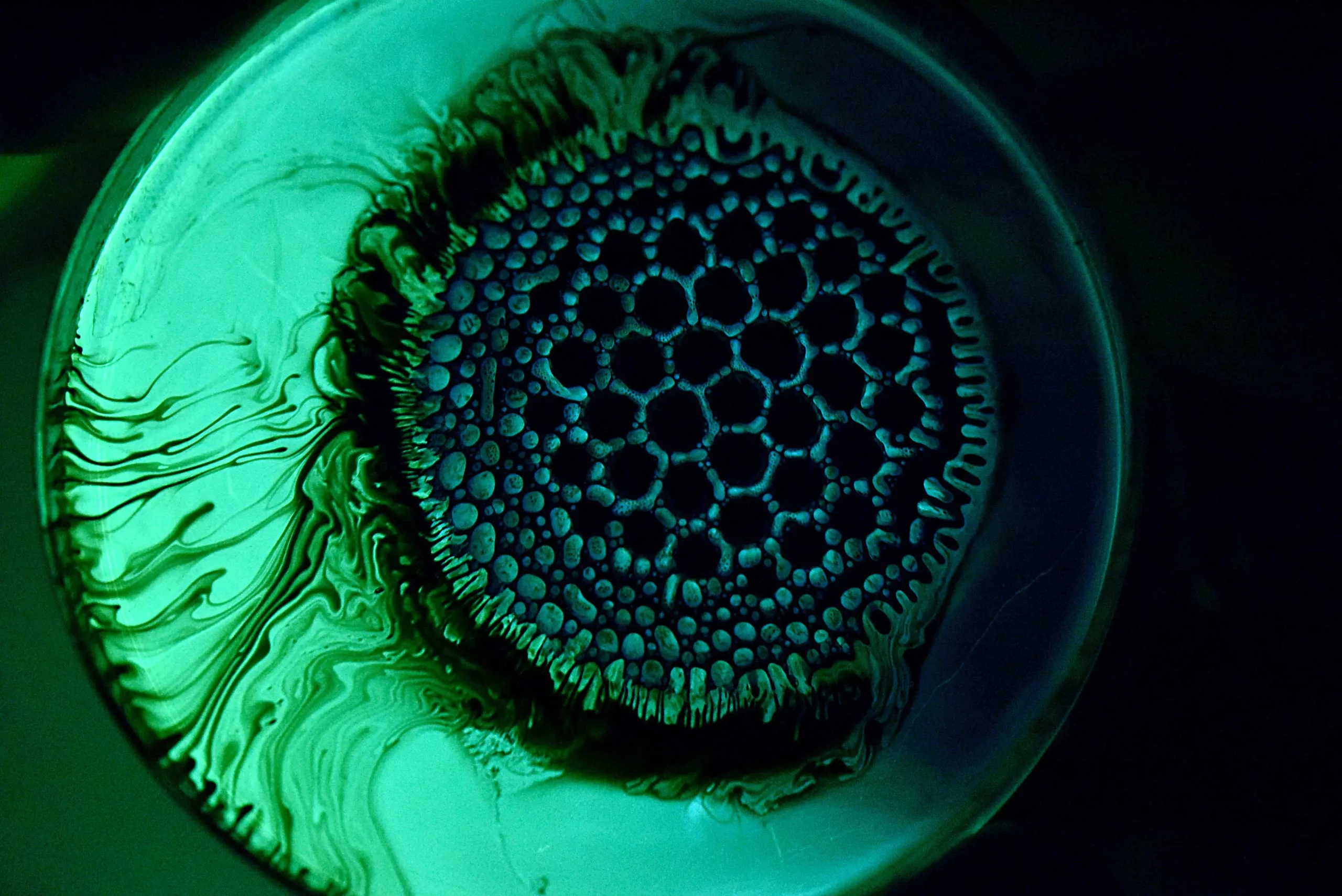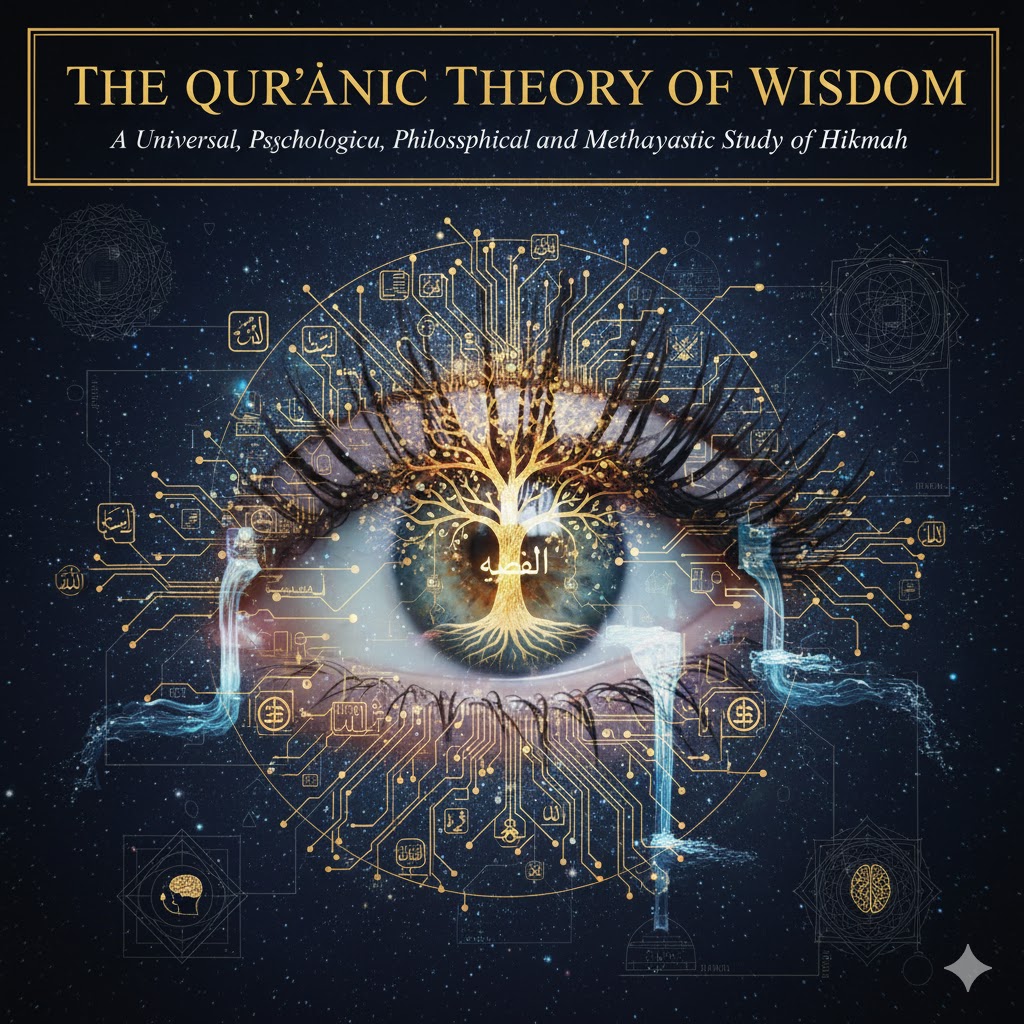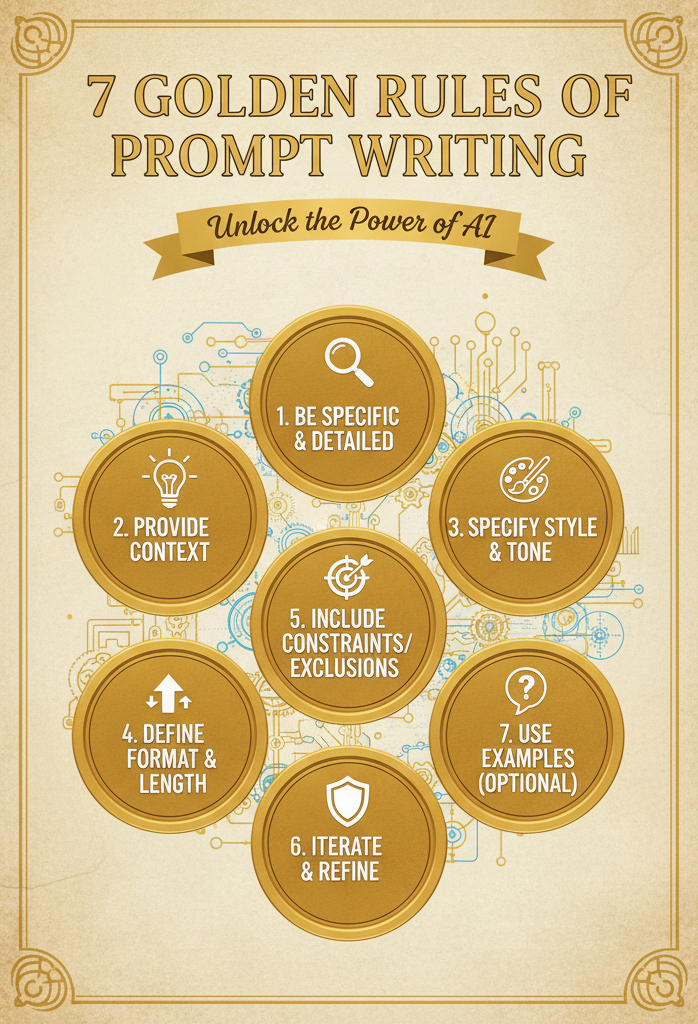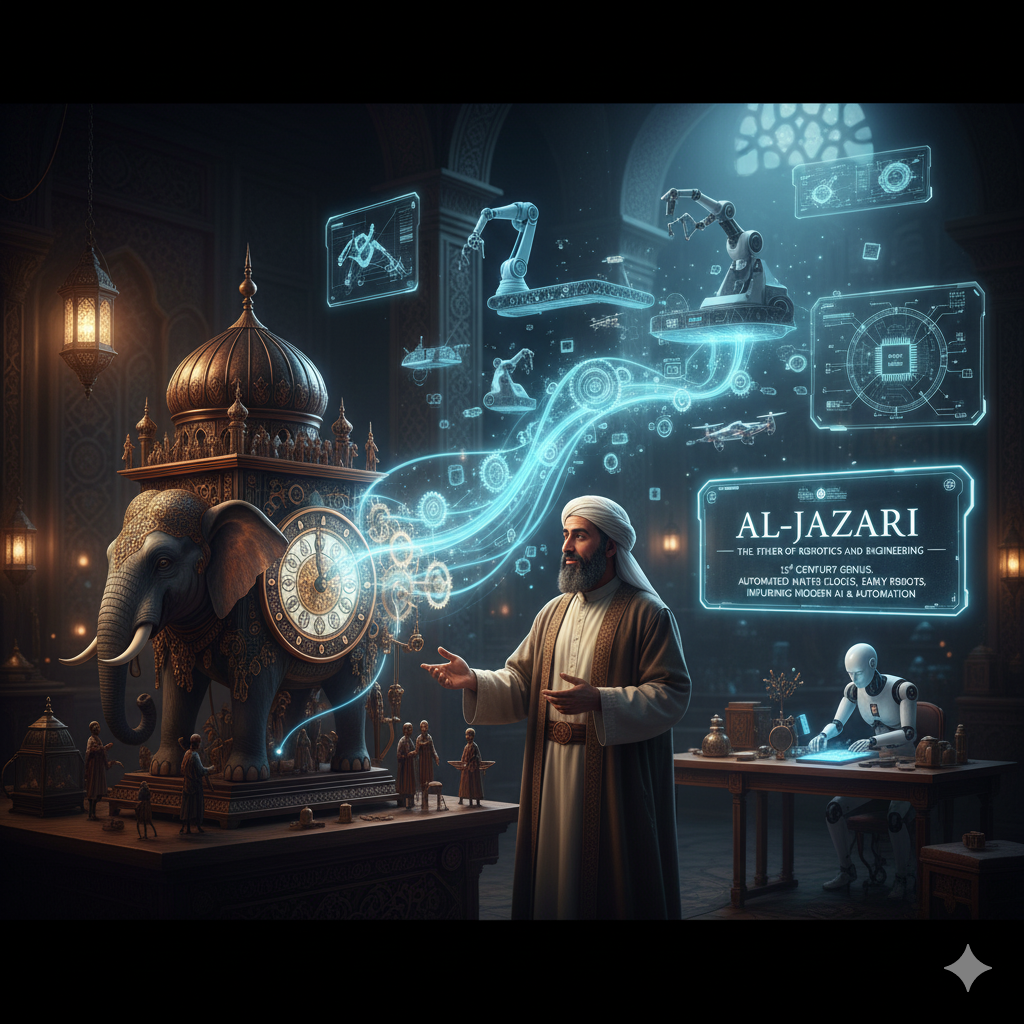The Genius Who Made Machines Come Alive
In an age when candles were the brightest lights of the night and time was measured by the stars, one man imagined a world where machines could think, move, and serve.
That man was Badiʿ al-Zaman Abu al-ʿIzz Ismail ibn al-Razzaz al-Jazari, known to history as Al-Jazari — the father of robotics and modern engineering.
Born in the 12th century, during the Islamic Golden Age, Al-Jazari lived in a time when science, art, and faith were one. The mosques echoed with the voices of scholars, libraries brimmed with manuscripts, and the thirst for knowledge was seen as a form of worship. In this world of enlightenment, Al-Jazari stood as a shining fusion of intellect and imagination — a man who did not just observe the wonders of creation, but sought to recreate them with his own hands.
To him, metal and water were not lifeless materials; they were obedient servants of divine design. Where others saw cogs and levers, he saw purpose. Where others saw fountains, he saw the heartbeat of time.
He believed that by understanding motion, proportion, and balance, one could touch the very language of God — the geometry of creation.
Working under the Artuqid dynasty in the city of Diyarbakir (in present-day Turkey), Al-Jazari transformed engineering into both science and spectacle. His creations were not mere contraptions — they were living marvels of imagination and logic: water clocks that marked time with elegance, automata that entertained kings, and mechanical systems that powered palaces.
He was not only an inventor but a storyteller of machinery. Each of his designs carried symbolism — a fusion of cultures, from the Indian elephant to the Greek water wheel, from Persian artistry to Islamic spirituality. His most famous masterpiece, the Elephant Clock, was not only a timekeeping device but a declaration: that knowledge has no borders, and wisdom belongs to all humanity.
Eight centuries before modern robotics, before engines or artificial intelligence, Al-Jazari envisioned what the world would later call automation — machines that could act according to designed logic, predict motion, and respond to the environment.
His genius was not accidental. It was the product of discipline, devotion, and divine curiosity. For Al-Jazari, creating a machine was not about replacing man — it was about magnifying the glory of the Creator. Every motion, every drop of water that powered his clocks, was a reflection of Allah’s perfect order in the universe.
When his book, “Kitab fi Ma‘rifat al-Hiyal al-Handasiyya” (The Book of Knowledge of Ingenious Mechanical Devices), was completed in 1206 CE, it became a beacon of mechanical wisdom — a masterpiece that bridged art and science. Within its pages were over a hundred inventions, each drawn, explained, and tested. It was the first technical encyclopedia of automation, centuries before industrial blueprints ever existed.
Through his inventions, Al-Jazari whispered a message across time:
“The mind that creates for the service of man honors the Creator Himself.”
His work reminds us that technology was not born in the West, nor did it begin in the Industrial Revolution. It began in the hands of men like Al-Jazari — artisans of faith, who merged the sacred and the scientific to shape a better world.
Even today, his legacy beats within every robotic arm, every mechanical pump, and every clock that marks our hours. He was, and remains, a visionary of motion — the man who made machines dance to the rhythm of reason.
1. Early Life and Background
Al-Jazari was born around 1136 CE in the ancient city of Al-Jazira, nestled between the Tigris and Euphrates rivers, in what is now southeastern Turkey. This fertile region, once home to Mesopotamian civilization, was known as the cradle of ingenuity — where agriculture, mathematics, and written language had first flourished. It was here, amid the echoes of ancient invention, that young Ismail ibn al-Razzaz first opened his eyes to a world of gears, pulleys, and flowing water.
His father, al-Razzaz, was himself a skilled craftsman and engineer in the service of the Artuqid court of Diyarbakir. From an early age, the boy observed his father at work — repairing fountains, designing water-raising devices, and perfecting hydraulic mechanisms for palaces and mosques. For Al-Jazari, the workshop became a school of precision and wonder, the place where imagination met discipline.
Unlike many scholars of his time who studied only philosophy or theology, Al-Jazari grew up at the intersection of faith and function. He was surrounded by mechanical artisans, mathematicians, and astronomers, all employed by the Artuqid rulers, who valued science as both a tool of governance and a reflection of divine harmony. The court was a hub of learning — filled with manuscripts, instruments, and debates on geometry, astronomy, and mechanics.
Al-Jazari’s education was deeply practical. He learned by doing — crafting, observing, and refining. Yet, his understanding of mechanics was never detached from spirituality. To him, every device was an act of devotion, every successful design a small reflection of Allah’s perfect order. This spiritual lens gave his inventions an artistry unmatched in his era.
By his mid-thirties, Al-Jazari had already earned a reputation for mechanical brilliance. His early work on water clocks and automated fountains caught the attention of the Artuqid king, Nasir al-Din Mahmud, who appointed him as chief engineer and inventor of the royal court. This position would define his life — giving him access to royal workshops, unlimited resources, and a platform to transform mechanical theory into breathtaking reality.
In the quiet corridors of the Artuqid palace, with tools of brass and wood, Al-Jazari began the experiments that would one day inspire the foundations of modern robotics. His mind became a bridge between the ancient world and the technological age to come — a reminder that even in the 12th century, Muslim civilization was already building the machinery of the future.
2. The Book of Knowledge of Ingenious Mechanical Devices
In 1206 CE, shortly before his death, Al-Jazari completed his monumental work:
“Kitab fi Ma‘rifat al-Hiyal al-Handasiyya”
(The Book of Knowledge of Ingenious Mechanical Devices)
This book is one of the greatest engineering manuscripts in history. It contains over 100 detailed mechanical designs, including drawings, materials, and operating principles. His illustrations — stunning in both precision and artistry — were centuries ahead of Leonardo da Vinci.
The book was divided into six chapters, each describing machines for daily life, entertainment, timekeeping, and engineering marvels. It was not just theory — every device was tested, functional, and practical.
3. Major Inventions and Engineering Achievements – The Architect of Motion
In the golden age of Islamic civilization, when knowledge flowed through the libraries of Baghdad, Damascus, and Cordoba, Al-Jazari stood as the master of machines — a man whose mind could make metal breathe and water sing. His inventions were not mere devices; they were mechanical symphonies, harmonizing art, engineering, and faith.
Between 1200 and 1206 CE, Al-Jazari completed his monumental masterpiece, “Kitab fi Ma‘rifat al-Hiyal al-Handasiyya” — The Book of Knowledge of Ingenious Mechanical Devices. This encyclopedic work contained over 100 mechanical designs, each meticulously illustrated and described. It was not only a record of inventions but a vision of what engineering could become: a dialogue between imagination and precision.
⚙️ The Elephant Clock – A Symbol of Unity and Genius
Among his most celebrated creations was the Elephant Clock, a magnificent, multi-cultural marvel that symbolized the universality of human knowledge. This clock was more than a timekeeping device — it was a philosophical statement.
Standing tall and ornate, it featured an Indian elephant (symbolizing Asia), an Egyptian phoenix, a Persian carpet, a Greek automaton, and Arabic calligraphy — each representing a civilization whose wisdom contributed to the progress of humanity.
The mechanism was ingenious: water dripping into a concealed bucket caused a float to descend, triggering a chain of gears and pulleys. These, in turn, set in motion a sequence of mechanical figures — birds, serpents, and human automata — that moved to mark the passing hours. It was the world’s first multicultural machine, and a masterpiece of engineering that combined hydraulic principles, mechanical automation, and aesthetic symbolism centuries ahead of its time.
💧 Water-Raising Machines – Engineering for Life
In an era where agriculture sustained empires, water was power — and Al-Jazari mastered its command. He designed several water-raising devices that used gears, cranks, and reciprocating pistons — mechanisms that would later influence the design of modern pumps and engines.
One of his remarkable innovations was the double-acting piston pump — a device that used suction and pressure to lift water continuously. This was the earliest known example of a crankshaft mechanism, the very principle that would one day drive the internal combustion engine and modern machinery.
🕰️ Automata and Mechanical Servants – The Dawn of Robotics
Al-Jazari’s genius extended beyond utility — he gave machines the illusion of life. In the royal courts of Diyarbakir, guests were often mesmerized by his automated peacocks, musicians, and serving machines.
One famous design was a mechanical waitress that served drinks. When the cup was placed on a tray, the automaton — powered by a hidden system of siphons and weights — gracefully poured liquid into the cup, bowing slightly as if in service.
In another creation, he designed a musical boat featuring mechanical drummers and flutists who played rhythmic tunes as it floated across royal ponds. These inventions made Al-Jazari the first true roboticist in human history — a man who merged creativity with mechanical logic long before the age of electricity or circuits.
🔧 The Precision Engineer
Every machine Al-Jazari built reflected a meticulous understanding of geometry, hydraulics, and material science. He invented sophisticated locking mechanisms, combination locks, and clocks powered by flowing water, oil, or mercury.
His attention to detail transformed craftsmanship into a science of motion. He introduced the concept of mechanical standardization — meaning parts could be replaced or replicated with consistent accuracy. This idea would later become the foundation of modern industrial manufacturing.
4. Philosophy of Invention
Al-Jazari’s genius was not mechanical alone — it was spiritual. He believed that engineering was a reflection of divine order, and that every mechanism mirrored the precision of Allah’s creation.
He wrote in his book:
“The craftsman imitates the Creator when he orders motion from stillness, and purpose from matter.”
For him, science was not separate from faith — it was the language through which God’s laws were understood.
He balanced imagination and discipline, ensuring that every device served human need — whether for irrigation, time, or joy. His machines were poetry in motion, combining geometry, hydraulics, and art into one seamless harmony.
5. Influence on Later Science and Engineering
Centuries passed after Al-Jazari’s death in 1206 CE, yet his machines refused to fade into the dust of forgotten invention. His ideas — carefully inked onto parchment in The Book of Knowledge of Ingenious Mechanical Devices — became seeds of inspiration for future generations of scientists, engineers, and visionaries.
Where others saw the boundary between man and machine, Al-Jazari saw a partnership — a divine harmony between human intellect and mechanical creation. That vision would ripple outward, reshaping the very foundations of mechanical science.
🔩 From Al-Jazari to Leonardo da Vinci – The Hidden Line of Inheritance
Though separated by continents and faiths, Leonardo da Vinci and Al-Jazari shared a singular passion: to give life to mechanisms. Scholars believe that Al-Jazari’s illustrated manuscripts, translated and circulated through the libraries of Baghdad and later Andalusia, reached Europe during the 13th and 14th centuries — influencing the Italian Renaissance.
Da Vinci’s sketches of gears, automata, and hydraulic systems bear an uncanny resemblance to Al-Jazari’s earlier designs. The hydraulic clocks, crankshaft mechanisms, and self-operating machines Leonardo admired had already been brought to life by Al-Jazari three centuries earlier.
Modern historians often call him “The Engineer Who Dreamed Before the Renaissance” — the silent architect of a future he would never see.
🤖 The Birth of Robotics and Automation
Al-Jazari’s concept of automata — machines that performed human-like actions — laid the foundation for robotics as we understand it today. His designs were not mechanical toys but intelligent systems governed by precise engineering principles: feedback loops, timing control, and sequential operation.
In his famous peacock fountain, for example, when water filled the bird’s belly, its eyes would glow and wings would flutter — a primitive form of mechanical programming that used water pressure and motion as signals. This principle would one day evolve into control systems — the heart of robotics, from industrial machines to artificial intelligence.
In essence, Al-Jazari built the soul of the robot long before the word “robot” existed.
⚙️ Engineering Beyond Imagination
Modern engineers still study Al-Jazari’s designs to understand how such complexity was achieved without modern tools. His use of gears, levers, valves, and camshafts demonstrated an intuitive grasp of mechanics centuries ahead of industrial science.
His water clocks introduced mechanical escapements — mechanisms that controlled energy release — a precursor to the systems that later powered mechanical watches and engines.
Even today, NASA engineers and roboticists acknowledge his contribution as the “genesis of automation.” In 1974, UNESCO recognized Al-Jazari’s work as one of the cornerstones of engineering history, declaring that his inventions marked “the transition from manual mechanics to systematic engineering.”
🌍 A Legacy Carved in Metal and Memory
From the palaces of Diyarbakir to the laboratories of Silicon Valley, Al-Jazari’s shadow lingers. His genius proves that innovation knows no age — that imagination, guided by purpose, can build machines that outlive empires.
His mechanical marvels were not born out of greed or glory but out of service to humankind — to make water flow, time count, and art move. He was, in every sense, the father of modern robotics, the patron saint of engineers, and the bridge between faith and reason.
Philosophy, Vision, and Legacy in the Modern Context – When Faith Met Mechanics
In the heart of the medieval Islamic world, science was not separate from faith — it was a reflection of divine order. For Al-Jazari, every gear, every drop of water, and every motion of a mechanical bird was an act of worship — a testimony that the Creator designed the universe with perfect precision, and it was the duty of the human mind to understand and emulate that perfection.
Where Greek philosophers saw logic and European alchemists saw mystery, Al-Jazari saw purpose — the divine harmony between thought, creation, and motion. His machines did not merely function; they glorified order, discipline, and ingenuity — virtues deeply rooted in the Qur’anic worldview.
“And He it is Who has made the stars for you, that you may be guided thereby through the darkness of the land and the sea…”
(Surah Al-An’am 6:97)
To Al-Jazari, this verse was not just about navigation — it was about understanding divine mechanics: how the cosmos itself is an engine of balance, motion, and design. His mechanical creations — from the Elephant Clock to the musical automata — were reflections of that cosmic order, miniatures of divine engineering.
⚙️ The Spiritual Dimension of Engineering
Unlike modern inventors driven by profit or prestige, Al-Jazari built with moral intention. Each device he designed served a purpose — to ease human labor, conserve resources, and beautify existence. His approach embodied the Islamic principle of Ihsan — excellence and beauty in every act, whether in prayer or design.
He believed machines were extensions of human virtue — that precision, harmony, and creativity mirrored the divine attributes of knowledge and power (Al-‘Aleem and Al-Qadir). For him, building was a spiritual act; to invent was to understand God’s creation.
🕰️ A Legacy That Shaped Modern Ethics in Technology
In the 21st century, as humanity debates artificial intelligence, automation, and the ethics of robotics, Al-Jazari’s philosophy feels profoundly relevant. His machines were never made to replace humanity — they were made to serve it.
He envisioned a world where machines amplify human goodness, not greed. A world where the engineer’s role is that of a steward — a caretaker of balance between invention and moral responsibility.
This idea — that technology must be guided by ethics — has resurfaced in modern robotics. Philosophers and engineers now discuss “responsible automation,” a concept Al-Jazari practiced eight centuries earlier.
🌍 Eternal Influence
Today, his name adorns museums, engineering schools, and research institutes across the world. Scholars reconstruct his machines, marveling at how medieval craftsmanship achieved mechanical logic without electricity.
From hydraulic clocks to programmable automata, his designs remain a living classroom — teaching that innovation without wisdom is empty, and that true genius lies not in the machine itself, but in the intention that gives it purpose.
In Al-Jazari, the world sees not just an inventor — but a bridge between faith and science, between art and engineering, and between the medieval past and the technological future.
His name echoes like the rhythm of his water clocks — steady, precise, eternal. And in that timeless motion lies a truth he would have loved:
When knowledge is guided by virtue, invention becomes worship.












